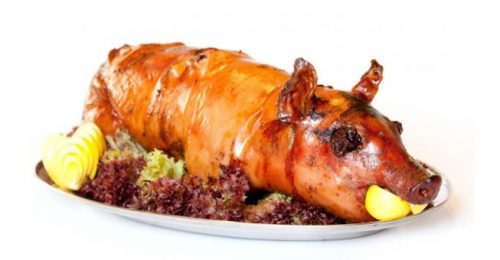With Founders’ Authentic Menus
The Clarke House Dining Room.
“Over the river and through the wood to Grandmother’s house we go” was sung frequently by carolers in the late 19th century. If these singers were heading toward Prairie Avenue, they may indeed have crossed the Chicago River and traversed through the considerable woods that were still in existence.
Once they arrived at their destination, family and friends were in for holiday treats that would be rare delicacies for most of Chicago’s population. Several of this hallowed street’s residents founded or were in upper management in grocery firms, and were well-suited to provide feasts. Samuel Tolman, who lived at 2031 Prairie Ave., was the vice president of the grocery company that bore his family name. John Wesley Doane, at 1827 Prairie Ave., presided over his family’s tea company. Marshall Field, whose mansion stood at 1905 Prairie Ave., was known to have private rail cars of exquisite food shipped from New York City’s most elegant restaurants. He also stocked fine food in his own wildly popular department store. Finally, some of the best cuts of meat to be found anywhere would be prepared by the cooks at Philip D. Armour’s home at 2115 Prairie Ave.
This opulent dining room belonged to Joseph Sears.
Prairie Avenue families typically consumed meals that were considered quite upscale for the time. During the holiday season, their cuisine existed on a grand scale that few of us can imagine today. Why and how did wealthy Chicagoans celebrate with meals fit for royalty? As mentioned above, many of the city’s founders made their fortune in providing food. Naturally, meat packing barons and grocery store kings had a natural inclination to eat well. With wealth came the privilege of having lots of help. As those of us who followed Downton Abbey know, affluent families had a retinue of staff to assist them in every conceivable way. Although Prairie Avenue residents many not have had the sheer number of people “downstairs” as the Earl of Grantham, they would have had a well-equipped kitchen crew. Chicagoans most desirous of impressing their guests went out of their way to hire French chefs, as Parisian cuisine was then very much in vogue.
The Glessner family had a modern, well-stocked pantry.
A typical holiday meal was served in many courses with libations to accompany each course. Women in their tightly-laced corsets would likely gaze in fear at the sheer amount of food they could be expected to consume. A visitor not educated in the complex etiquette of the time would be dismayed at the array of silverware and wine glasses at each place setting. Specially printed menus would be placed at each seat, so guests would have an idea as to what to expect and consume accordingly.
A hand-painted menu from an 1894 dinner party given by Mrs. Harry Hammer.
Not surprisingly, Chicagoans had a wealth of choices for the many varieties of meat and seafood that were expected at a special meal. When Prairie Avenue was at its apex as a residential area, oysters were a prized delicacy, and no meal was complete without them in some form.
Appetizers
Raw Oysters with Relish
Olive/Pickle Tray
Soups and Garnishes
Chestnut Soup
Sweet Potato Balls
Seafood
Baked Shad with Shad Roe Sauce
Poultry
Roast Goose with Apple Stuffing
Celery Salad
Meat
Young Roast Pig
Asparagus
Desserts
English Walnut Cake
Charlotte Russe (cake)
Coffee, Crackers, Cheese
Amontillado, Chateau Rolland, Mumm’s Extra Dry, Cognac, Liqueur
A roast pig was a holiday favorite among Prairie Avenue families.
A cautionary tale, depending upon your choice of companion animals: According to the Prairie Avenue Cookbook, The Harvey children [1722 Prairie Ave.] had a pet piglet at the family’s summer home on Mackinac Island, which, unbeknownst to them, was being fattened for slaughter. The children remember with horror seeing their piglet, roasted, arrive at the Christmas table on the festive board garnished with mistletoe.”
Menu details courtesy of the Prairie Avenue Cookbook, available at the Glessner House Museum.













